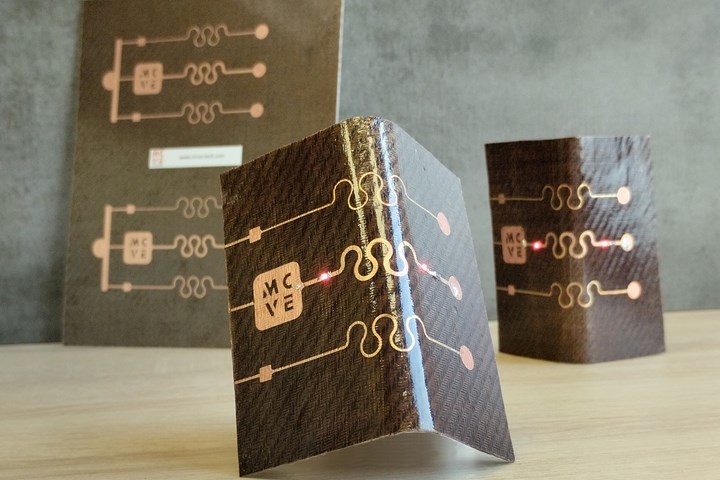Composites end markets: Electronics (2025)
Electronic and smart device innovations achieved through the use of advanced materials ranging from thermoplastic composites to biomaterials emphasize high-volume production and sustainability.

Composite materials are lending new design flexibility and enabling high-rate production for consumer electronics thanks to such material innovations as Syensqo’s Swyft-Ply material for fast-curing layered composite structures. Source | Syensqo
Composite materials continue to become increasingly important in the high-volume production of consumer electronics, offering lightweight, durable and aesthetically appealing solutions for devices such as smartphones, laptops and wearables. The design flexibility of composites enables the creation of sleek and ergonomic components while also aiding manufacturers in scaling production to meet growing consumer demand.
Beyond structural advantages, composites can be engineered for optimal thermal management, enabling the efficient dissipation of heat generated by electronic components. Glass fiber-reinforced polymers (GFRP) are well-suited to providing electrical insulation, and remain widely used in electronics, particularly in printed circuit boards (PCBs) — structures that create electrical connections between components in many devices. Carbon fiber, on the other hand, is increasingly turned to for its high strength-to-weight ratio, offering enhanced durability and impact resistance in high-wear applications such as smartphone and laptop covers.
Composites are also playing a key role in reducing reliance on metals and improving product recyclability. Recent advancements in thermoplastic composites have demonstrated their viability as sustainable alternatives, enabling manufacturers to create lighter, more durable and radio-transparent components while also aligning with global sustainability goals.
Design flexibility and high-volume production
In early 2024, Syensqo (Brussels, Belgium and Alpharetta, Ga., U.S.), formerly part of Solvay Group, launched Swyft-Ply, a new composite material brand designed for the electronics and smart devices market. As the name implies, the material enables fast-curing layered composite structures. With the material, Syensqo aims to support the industry’s quick development cycles and high-volume production requirements by offering rapid processing, reduced secondary manufacturing costs and compatibility with other processes such as overmolding. The material is said to enhance design flexibility, enabling lighter, thinner and stronger device components. It also enables customization of dielectric performance, thermal characteristics and flammability resistance. Based on multiple polymer resin types and reinforcements, the Swyft-Ply portfolio of products is available in various material formats and is formulated to optimize processing efficiencies through fast-curing, controlled flow and extended storage.

Syensqo’s Ixef PARA resin is used in the construction of the Artiphon Chorda musical instrument based on sensing technology. Source | Syensqo
In another example of the ways composite materials enable design flexibility, in May 2024 Syensqo announced that musical instrument manufacturer Artiphon (Nashville, Tenn., U.S.) selected its Ixef polyarylamide (PARA) resin for the housing and keypad of Chorda, an electronic musical instrument commercialized in November 2023. Chorda uses capacitive sensing technology for a responsive and durable touch interface. The Ixef PARA resin provides high strength, rigidity, scratch resistance and dimensional stability, ensuring long-term durability and aesthetic appeal. Ixef PARA is said to exhibit an optimal flexural modulus that prevents bending and enables immediate sensitivity to user interactions. The material also offers partial translucency for LED visibility and can be molded in various colors.

Vaio portable monitor display casings use Teijin’s Tenax TPCL and Panlite Sheet materials. Source | Teijin Ltd.
In July 2024, Teijin Ltd. (Tokyo, Japan) announced the incorporation of its Tenax TPCL and Panlite Sheet materials into the housing of Vaio Vision+ portable displays, making them what is reported to be the world’s lightest portable monitors at 325 grams and 3.9 millimeters thin. Tenax TPCL, a carbon fiber-reinforced thermoplastic, provides strength, rigidity, heat and impact resistance, while Panlite Sheet, a polycarbonate resin, ensures dimensional stability and durability. The new design eliminates traditional metal parts, simplifying manufacturing, reducing CO₂ emissions and enabling complex shapes in a single molding step.
Enhanced performance
Ultimately, performance is key for the success of any device. Innovations in composite materials continue to improve the radio transparency, electrical stability and durability of consumer electronics.

This GPS tracker and car alarm navigation device is one electronic application example that incorporates SABIC’s LNP Thermocomp WF006V grade. Source | SABIC
In 2023, SABIC (Riyadh, Saudi Arabia) introduced a glass fiber-reinforced LNP Thermocomp WF006V compound, formulated for laser direct structuring (LDS) of antennas used in the housings and covers of consumer electronics, appliances and other electronic components.
LDS offers an alternative to traditional flexible printed circuit antennas, SABIC reports, enabling complex, miniaturized designs, faster production and lower costs. LDS technology allows antennas to be directly structured on 3D molded surfaces, supporting space-saving integration, easier prototyping and cost-effective mass production.
LNP Thermocomp WF006V exhibits increased tensile modulus compared to unfilled polybutylene terephthalate or polycarbonate resin. It also has increased chemical resistance, hydrolytic stability and lower warpage compared to traditional glass fiber-reinforced materials, preventing such issues as surface defects, warping and excessive moisture absorption.

Snapdragon G3x Gen 2 gaming platform. Source | Carbon Mobile
In March 2023, Carbon Mobile (Berlin, Germany), a startup company that develops radio-enabled carbon fiber composites in electronics devices, announced a collaboration with SABIC to drive industry-wide adoption of next-gen, advanced carbon fiber composites in smart devices. The partnership enables Carbon Mobile to leverage SABIC’s range of composite materials, including the company’s Trucircle portfolio of materials designed for recyclability. This includes resins tailored with improved recyclability characteristics; compounds with high recycled content and booster resins for recyclate-containing compounds; and resins and chemicals produced through bio-based feedstocks.
Carbon Mobile is known for its patented HyRECM technology, which effectively stabilizes carbon fiber’s electrical and antenna properties to meet the requirements of electronic devices. This technology enables the creation of devices that are not only lighter and slimmer but also more durable, the company reports.
Carbon Mobile has used HyRECM to produce a robust carbon fiber composite monocoque housing structure for a very thin and light smartphone, with the least amount of material possible. To further boost the device’s connectivity, a conductive ink trace is integrated into the carbon fiber structure to stabilize the electrical and wireless properties. In 2001, the technology was featured on Carbon Mobile’s Carbon 1 MKII smartphone.
In 2024, Carbon Mobile partnered with Qualcomm Technologies (San Diego, Calif., U.S.) to develop a new generation of Qualcomm Technologies reference designs using carbon fiber. Its first collaboration features a Snapdragon G3x Gen 2 gaming platform, offering WiFi 7 and 5G connectivity for cloud gaming. The new design is lighter than its predecessor and opens the door for integrating recycled and bio-based materials to reduce e-waste.
Meanwhile, Saint-Gobain Advanced Ceramic Composites (ACC, Pierre-lès-Nemours, France) is developing quartz fibers for the copper clad laminates (CCL) used in printed circuit boards (PCB) to support high frequency signals. “More data and connectivity mean higher frequencies are used,” explains Aymeric d'Ydewalle, general manager of Saint-Gobain ACC. He notes that above 30 gigahertz, the dielectric properties of typical reinforcements like glass fiber would damage the integrity of the signal, which can cause the PCBs to become slow or unreliable and ultimately degrade the electronics.
“And with AI, there is a tremendous increase in the amount of data that needs to be processed, which also demands extremely high frequencies,” adds d’Ydewalle. “These applications thus demand better hardware. Basically, you would have less processability and less capability to process the data if you used glass fiber PCBs.”
As part of meeting this market demand, Saint-Gobain ACC is developing new quartz fiber products sized much smaller than the 9- and 14-micron-diameter yarns used in aerospace, down to 7 microns or even less. It is also investing in R&D to meet the electronics industry’s future needs.

Proof of concept made with biocomposite flax fibers, PA10-10 bio-sourced resin and thermoformed printed circuitry. Source | MCVE Technologie
Recyclability in electronics
Environmental responsibility, sustainability considerations and a growing use of recycled materials play an increasingly important role in the manufacture of electronics.
In April 2024, MCVE Technologie (Augny, France) unveiled 3DFlaxtronics, an in-mold electronics (IME) technology available as highly functional films integrated into flax fiber organosheets with the aim of supporting high-rate production of conformable electronics such as antennas, circuits and heating elements. Industries targeted include automotive, aerospace, consumer electronics, medical, sports and packaging.
The process uses a copper-based formulation called Eoprom to adhere electronic surface-mount device components onto a 0.5-millimeter-thick flax organosheet reinforced with bio-sourced polyamide 10-10 resin. The thermoformable organosheets can then be used to produce a variety of smart, eco-friendly electronic components with enhanced functionality and design flexibility. Potential applications include haptic controls with interactive responses, vehicle interior buttons, home appliance interfaces, and temperature and pressure sensors.
In 2023, Swancor (Nantou, Taiwan) introduced EzCiclo low-dielectric epoxy hardener tailored for copper-clad laminates, enabling the use of recycled waste plastics in PCB production. Using a chemical process, the company converts waste plastics into active ester oligomers, which serve as epoxy resin hardeners. According to Swancor, EzCiclo retains the properties of traditional hardeners while incorporating more than 80% recycled materials and enhancing electrical performance. PCBs made with this hardener can be decomposed using Swancor’s CleaVER chemical treatment, enabling material separation for recycling.
The future of composites in electronics
As consumer electronics continue to evolve, composite materials will continue to play a crucial role in shaping the future of device design and manufacturing. From enhancing durability and performance to enabling increased production and more lightweight and ergonomic structures, the integration of cutting-edge composite technologies will remain essential in pushing the boundaries of design, efficiency and environmental responsibility in electronics.
Related Content
Syensqo launches Swyft-Ply brand for electronics, smart devices
Multifunctional composites leverage traditional advanced material benefits while meeting specific industry manufacturing and performance requirements.
Read MoreExel secures design patent extension for pultruded fiberglass radomes
Technique for antenna radomes forms “functional zones” inside composite material, enhancing existing 5G technology performance, application potential.
Read MoreCarbon Mobile carbon fiber powers handheld gaming platform
HyRECM technology effectively stabilizes carbon fiber’s electrical and antenna properties, enabling development of next-gen electronics, such as the Snapdragon G3x Gen 2.
Read MoreTeijin lightweight materials enable VAIO portable displays
Teijin's Tenax TPCL and Panlite Sheet materials allow for the creation of complex, three-dimensional shapes in a single molding step.
Read MoreRead Next
Composites end markets: New space (2025)
Composite materials — with their unmatched strength-to-weight ratio, durability in extreme environments and design versatility — are at the heart of innovations in satellites, propulsion systems and lunar exploration vehicles, propelling the space economy toward a $1.8 trillion future.
Read MoreComposites end markets: Sports and recreation (2025)
The use of composite materials in high-performance sporting goods continues to grow, with new advancements including thermoplastic and sustainability-focused materials and automated processes.
Read MoreVIDEO: High-volume processing for fiberglass components
Cannon Ergos, a company specializing in high-ton presses and equipment for composites fabrication and plastics processing, displayed automotive and industrial components at CAMX 2024.
Read More






















